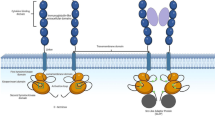Abstract
In some cases of childhood acute megakaryoblastic leukemia (AMKL), G-band analysis reveals supernumerary ring/marker chromosomes along with monosomy 7. However, their origin and relevance are poorly understood. We experienced three patients with AMKL, one of whom had Down’s syndrome, whose blasts at the first visit exhibited both monosomy 7 and a ring/marker chromosome. For one case, precise molecular-cytogenetic techniques revealed that the ring chromosome was derived from a chromosome 7. It was strongly suggested that the ring chromosome was derived from a chromosome 7 in another case. The ring or one of the 2 marker chromosomes was derived from a chromosome 7 in the other case. All patients responded well to initial induction therapy. While it is not clear whether the ring/marker chromosome 7 affects the long-term prognosis of acute myeloid leukemia with monosomy 7, it may be of prognostic relevance to distinguish pure monosomy 7 from monosomy 7 with a ring/marker chromosome 7. For this purpose, conventional G-banding could be complemented with additional techniques such as spectral karyotyping or fluorescence in situ hybridization, which characterize the aberration in more detail. These methods may be useful for determining the optimal treatment and for elucidating the etiology of AMKL itself.

Similar content being viewed by others
References
Rubnitz JE. Childhood acute myeloid leukemia. Curr Treat Options Oncol. 2008;9:95–105.
Gassmann W, Loffler H. Acute megakaryoblastic leukemia. Leuk Lymphoma. 1995;18(1):69–73.
Grimwade D, Walker H, Oliver F, et al. The importance of diagnostic cytogenetics on outcome in AML: analysis of 1,612 patients entered into the MRC AML 10 trial. The Medical Research Council Adult and Children’s Leukaemia Working Parties. Blood. 1998;92:2322–33.
Athale UH, Razzouk BI, Raimondi SC, et al. Biology and outcome of childhood acute megakaryoblastic leukemia: a single institution’s experience. Blood. 2001;97:3727–32.
Hama A, Yagasaki H, Takahashi Y, et al. Acute megakaryoblastic leukaemia (AMKL) in children: a comparison of AMKL with and without Down syndrome. Br J Haematol. 2008;140:552–61.
Bourquin JP, Subramanian A, Langebrake C, et al. Identification of distinct molecular phenotypes in acute megakaryoblastic leukemia by gene expression profiling. Proc Natl Acad Sci USA. 2006;103:3339–44.
Kudo K, Kojima S, Tabuchi K, et al. Prospective study of a pirarubicin, intermediate-dose cytarabine, and etoposide regimen in children with Down syndrome and acute myeloid leukemia: the Japanese Childhood AML Cooperative Study Group. J Clin Oncol. 2007;25:5442–7.
Tsukimoto I, Tawa A, Horibe K, et al. Risk-stratified therapy and the intensive use of cytarabine improves the outcome in childhood acute myeloid leukemia: the AML99 trial from the Japanese Childhood AML Cooperative Study Group. J Clin Oncol. 2009;27:4007–13.
Gebhart E. Ring chromosomes in human neoplasias. Cytogenet Genome Res. 2008;121:149–73.
Gibson BE, Wheatley K, Hann IM, et al. Treatment strategy and long-term results in paediatric patients treated in consecutive UK AML trials. Leukemia. 2005;19:2130–8.
Hasle H, Alonzo TA, Auvrignon A, et al. Monosomy 7 and deletion 7q in children and adolescents with acute myeloid leukemia: an international retrospective study. Blood. 2007;109:4641–7.
Frohling S, Skelin S, Liebisch C, et al. Comparison of cytogenetic and molecular cytogenetic detection of chromosome abnormalities in 240 consecutive adult patients with acute myeloid leukemia. J Clin Oncol. 2002;20:2480–5.
Bunin N, Nowell PC, Belasco J, et al. Chromosome 7 abnormalities in children with Down syndrome and preleukemia. Cancer Genet Cytogenet. 1991;54:119–26.
Kobayashi K, Usami I, Kubota M, et al. Chromosome 7 abnormalities in acute megakaryoblastic leukemia associated with Down syndrome. Cancer Genet Cytogenet. 2005;158:184–7.
Gisselsson D, Hoglund M, Mertens F, et al. The structure and dynamics of ring chromosomes in human neoplastic and non-neoplastic cells. Hum Genet. 1999;104:315–25.
Raimondi SC, Chang MN, Ravindranath Y, et al. Chromosomal abnormalities in 478 children with acute myeloid leukemia: clinical characteristics and treatment outcome in a cooperative pediatric oncology group study-POG 8821. Blood. 1999;94:3707–16.
Author information
Authors and Affiliations
Corresponding author
About this article
Cite this article
Fujino, H., Fujita, N., Hamamoto, K. et al. Ring/marker chromosome derived from chromosome 7 in childhood acute megakaryoblastic leukemia with monosomy 7. Int J Hematol 92, 386–390 (2010). https://doi.org/10.1007/s12185-010-0663-0
Received:
Revised:
Accepted:
Published:
Issue Date:
DOI: https://doi.org/10.1007/s12185-010-0663-0




